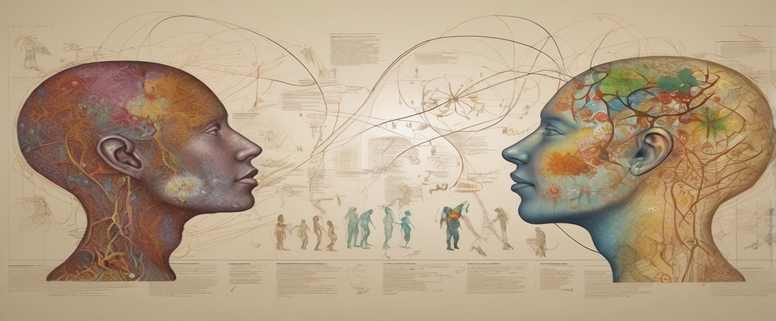Introduction: Transcending Survival Mode
We are not here merely to survive; we are here to evolve. This simple yet profound shift in perspective transforms how we understand the human journey and technology's role within it. Throughout much of our history, survival concerns dominated human existence—securing food, shelter, safety, and reproduction absorbed most of humanity's energy and creativity. This survival-focused existence was not by choice but necessity, as the fundamental challenges of physical existence demanded immediate attention.
The technological revolutions of the past few centuries have increasingly liberated many humans from these baseline survival imperatives. Agricultural technology ensured reliable food production; industrial technology created material abundance; medical technology extended lifespans and reduced suffering; digital technology democratized information access and connection. Each advancement has shifted more human consciousness away from immediate survival concerns and toward broader possibilities.
Yet despite these shifts in material conditions, survival thinking continues to dominate much of our culture, economics, and technology development. We build technologies primarily to solve problems rather than expand possibilities, to increase efficiency rather than enhance meaning, to protect against threats rather than nurture potential. This survival-oriented approach significantly limits technology's role in human advancement and artificially constrains our collective evolution.
This article explores an alternative framework: technology as a catalyst for human evolution beyond mere survival. Drawing from both philosophical perspectives and practical applications, I'll examine how shifting our fundamental orientation from survival to evolution creates different priorities for technological development. This shift doesn't dismiss survival needs but recognizes them as the foundation rather than the purpose of human existence—as the beginning rather than the end of our journey.
The philosophy that "we are not here to survive; we are here to evolve" isn't about transcending our humanity through technological enhancement, but about using technology to fulfill more of our inherent human potential. It's about creating conditions where the extraordinary capabilities latent within human consciousness can flourish rather than remaining dormant beneath the pressures of survival concerns.
Beyond Survival Thinking
Survival thinking—the mindset organized around securing existence against threats—manifests in distinctive patterns that shape both individual psychology and collective systems:
Patterns of Survival Thinking
Scarcity Orientation
Perception of fundamental insufficiency requiring competition for limited resources rather than creation of new possibilities.
Threat Vigilance
Hyperawareness of potential dangers that directs attention toward risk avoidance rather than opportunity exploration.
Short-Term Focus
Concentration on immediate outcomes rather than long-term development or implications.
Binary Thinking
Reduction of complex situations to simplified either/or frameworks focused on safety versus danger.
Control Prioritization
Emphasis on controlling variables to ensure security rather than engaging with complexity and emergence.
These patterns made evolutionary sense when immediate physical survival was genuinely precarious. Our ancestors needed these cognitive biases to navigate dangerous environments with limited margins for error. But as technology has created greater physical security for many humans, these same patterns have become limitations rather than advantages—cognitive relics that constrain potential rather than ensuring survival.
Survival thinking remains particularly evident in how we approach technology development and assessment:
Technology Development and Survival Thinking
Problem-Solution Framing
Technology primarily justified as solving existing problems rather than creating new capabilities or possibilities.
Risk Aversion
Excessive focus on potential technological harms that can prevent exploration of transformative benefits.
Efficiency Obsession
Optimization for doing existing things more efficiently rather than doing genuinely new things.
Competitive Advantage
Technology development driven by zero-sum competition rather than collective advancement.
Scarcity Preservation
Business models built around maintaining artificial scarcity rather than leveraging technological abundance.
Moving beyond survival thinking doesn't mean abandoning appropriate caution or ignoring genuine risks. Rather, it means developing a more balanced relationship with both opportunity and threat, possibility and limitation. It means creating space for evolutionary thinking alongside survival vigilance—allowing human consciousness and creativity to explore beyond the boundaries of mere existence maintenance.
This shift becomes increasingly important as artificial intelligence, biotechnology, and other advanced capabilities create unprecedented opportunities for either human flourishing or limitation. The mindset we bring to these technologies—survival or evolution—will significantly influence which potentials we explore and which we leave undeveloped.

The Evolutionary Imperative
Evolution, in this context, refers not primarily to biological evolution through natural selection but to the conscious development of human capabilities, understanding, and ways of being. This evolutionary perspective involves several key elements:
Key Elements of Evolutionary Perspective
Consciousness Expansion
Development of awareness beyond immediate concerns to encompass broader contexts, perspectives, and possibilities.
Capability Enhancement
Cultivation of human capacities for creativity, empathy, wisdom, and other advanced qualities that transcend survival functions.
Understanding Deepening
Progressive understanding of ourselves, others, and reality itself, moving from simplified models toward greater comprehension of complex systems.
Values Refinement
Evolution of what we consider important, meaningful, and worthy of pursuit beyond basic need satisfaction.
Relationship Transformation
Development of more conscious, compassionate, and mutual relationships with other humans, other species, and the environment.
This evolution doesn't happen automatically when survival needs are met. History shows that material abundance alone doesn't guarantee human advancement—it can as easily lead to complacency, novel forms of conflict, or sophisticated distraction as to genuine evolution. Conscious intention and appropriate frameworks are necessary to channel the energy formerly devoted to survival toward evolutionary purposes.
The evolutionary imperative becomes particularly relevant in the context of accelerating technological capability. As automation and artificial intelligence increasingly handle survival-oriented tasks, humanity faces a profound choice: either find evolutionary purposes that transcend survival or remain trapped in increasingly sophisticated but fundamentally limited survival-oriented patterns.
This choice appears across multiple domains:
Domains of Evolutionary Choice
Work Evolution
As automation reduces survival-driven labor, we can either struggle to preserve existing work patterns or reimagine human work around creativity, care, wisdom, and other evolutionary contributions.
Economic Evolution
As technology creates material abundance in many domains, we can either maintain artificial scarcity through restrictive systems or develop economics of flourishing focused on meaningful value creation and exchange.
Social Evolution
As connection technologies transform human interaction, we can either reproduce traditional tribal limitations in digital form or develop more conscious, compassionate forms of human relationship.
Knowledge Evolution
As information systems expand access to facts and data, we can either drown in information overload or develop wisdom systems that help integrate knowledge into meaningful understanding.
The evolutionary imperative suggests that the purpose of reducing survival burdens through technology isn't to create comfort or leisure alone, but to free human capacity for higher-order development. The energy, attention, and creativity previously consumed by survival concerns becomes available for evolutionary purposes—but only if we consciously direct it toward those ends rather than allowing it to dissipate in consumption or distraction.
This perspective aligns with observations from diverse wisdom traditions suggesting that human consciousness contains extraordinary undeveloped potential beyond what's required for physical survival. Technology can create conditions where more of this potential finds expression—not by replacing human capabilities but by removing obstacles to their full development.
Technology as an Evolutionary Catalyst
When approached from an evolutionary rather than merely survival perspective, technology takes on a different role—not just solving problems but catalyzing human advancement in multiple dimensions:
Catalyst Mechanisms
Constraint Removal
Eliminating obstacles that currently prevent the expression of latent human capabilities.
Feedback Enhancement
Providing more immediate, accurate, and useful feedback that accelerates learning and development.
Scaffolding Provision
Creating supportive structures that enable reaching beyond current capabilities toward new possibilities.
Environment Enrichment
Developing surroundings that stimulate and support human growth rather than merely ensuring survival.
Examples of evolutionary technology approaches can be found across diverse domains:
Examples of Evolutionary Technology
Information Technologies
Beyond mere data access, information systems that help users develop wisdom through contextualizing information, revealing relationships, and supporting meaning-making processes.
Communication Systems
Beyond efficient message transmission, communication technologies that enhance understanding across differences, support authenticity, and foster meaningful connection.
Educational Technologies
Beyond content delivery, learning systems that adapt to individual developmental paths, cultivate curiosity and creativity, and help integrate knowledge into practical wisdom.
Creation Tools
Beyond productivity enhancement, creation technologies that expand expressive possibilities, augment imagination, and support collaborative innovation.
Well-being Technologies
Beyond health maintenance, technologies that support flourishing through enhanced self-awareness, emotional intelligence development, and meaning creation.
These evolutionary applications share a common pattern: they don't replace human capabilities but create conditions where more of those capabilities can develop and find expression. They recognize technology's role not as substituting for humanity but as catalyzing its advancement beyond current limitations.
This catalytic function operates through several mechanisms:
Catalytic Mechanisms
Constraint Removal
Eliminating obstacles that currently prevent the expression of latent human capabilities.
Feedback Enhancement
Providing more immediate, accurate, and useful feedback that accelerates learning and development.
Scaffolding Provision
Creating supportive structures that enable reaching beyond current capabilities toward new possibilities.
Environment Enrichment
Developing surroundings that stimulate and support human growth rather than merely ensuring survival.
When technology performs these catalytic functions, it serves not merely human survival or comfort but our continued evolution as conscious beings capable of greater understanding, creativity, compassion, and wisdom.
AI and Human Potential
Artificial intelligence represents perhaps the most significant evolutionary catalyst currently emerging, with unprecedented potential to either limit or expand human development depending on how we approach it:
Beyond Replacement Thinking
The dominant narrative around AI often focuses on which human capabilities it might replace—which jobs will be automated, which decisions algorithms might make, which creative tasks machines might perform. This replacement framing reflects survival thinking, viewing technology primarily in competitive rather than catalytic terms.
An evolutionary perspective suggests different questions: How might AI help develop human capabilities that currently lie dormant? What aspects of human potential might flourish when freed from tasks that don't require uniquely human qualities? What new forms of human contribution might emerge in collaborative relationship with intelligent systems?
Rather than artificial intelligence replacing human intelligence, the most promising evolutionary approach involves developing complementary intelligences—systems with different strengths and limitations that can work synergistically with human cognition:
Complementary Intelligences
AI excels at pattern recognition across vast datasets; humans excel at contextual meaning-making
AI manages complexity through computational power; humans navigate complexity through intuition and wisdom
AI maintains consistent focus and attention; humans bring creativity and purpose
AI processes information without emotional bias; humans contribute empathy and values
When designed for complementarity rather than replacement, AI systems can help humans transcend current cognitive limitations while preserving the essential human elements of creativity, wisdom, empathy, and meaning-making.
Specific Evolutionary Applications
Specific Evolutionary Applications
Insight Amplification
AI systems that identify patterns and connections beyond individual human perception, helping expand understanding without replacing human meaning-making. For example, systems that analyze complex climate data to reveal non-obvious relationships, then present these patterns in ways that enhance human comprehension rather than simply providing recommendations.
Creative Collaboration
AI tools that extend creative possibilities through suggestion, variation, and implementation support without replacing human creative direction. For instance, design systems that generate numerous variations based on human creative intent, allowing exploration of possibilities that might otherwise remain unexplored.
Wisdom Development
AI approaches that support integration of knowledge into wisdom through contextualizing information, revealing diverse perspectives, and supporting reflection. For example, systems that help users see multiple viewpoints on complex issues, identify their own cognitive biases, and integrate diverse sources into coherent understanding.
Collective Intelligence
AI systems that enhance group intelligence by improving collaboration, highlighting complementary contributions, and helping bridge understanding across different viewpoints. For instance, meeting facilitation AI that helps diverse groups find common ground while preserving the value of differing perspectives.
Personalized Development
AI tools that support individual growth by identifying development opportunities, providing tailored learning experiences, and offering personalized feedback. For example, learning systems that adapt not just to knowledge gaps but to developmental readiness and optimal challenge levels.
The project I'm working on—building an AI version of myself—is about augmenting myself and improving all my skills. I'm certain that my abilities and understanding of the world will greatly improve, helping me work towards improving this world and turning it into the place I envision for my kids.
These applications demonstrate AI's potential role not as humanity's replacement but as a catalyst for our continued evolution—helping us become more fully human rather than less so.

Collective Intelligence Amplification
Perhaps the most significant evolutionary potential of technology lies in its ability to enhance collective human intelligence—our capacity to think, create, and solve problems together at scales previously impossible:
Beyond Individual Enhancement
While much attention focuses on how technology might enhance individual human capabilities, the most transformative possibilities involve amplifying collective intelligence—the emergent capabilities that arise from humans thinking together rather than separately. Throughout history, humanity's most significant achievements have come not from isolated genius but from collective knowledge development and collaborative problem-solving. Technology creates unprecedented possibilities for enhancing these collective capabilities.
Network Intelligence Architectures
Network Intelligence Architectures
Knowledge Integration Systems
Technologies that help connect insights across disciplines, perspectives, and knowledge domains that traditionally remain separate. These systems help overcome the fragmentation of understanding that limits collective problem-solving.
Collaboration Environments
Platforms designed specifically to enhance group thinking by improving coordination, highlighting complementary contributions, and facilitating synthesis across different viewpoints. These environments help transcend the limitations of traditional group processes.
Distributed Cognition Tools
Systems that distribute cognitive tasks across networks of humans and machines based on complementary strengths, creating capabilities beyond what either could achieve alone. These tools help overcome the bottlenecks created when complex problems exceed individual cognitive capacity.
Perspective Bridging Technologies
Platforms that help different viewpoints understand one another, find common ground, and integrate diverse insights. These technologies help address the polarization and tribalism that inhibit collective wisdom.
Collective Memory Systems
Tools that preserve and make accessible the insights, lessons, and knowledge developed through collective experience. These systems help societies overcome forgetting cycles that often lead to repeating preventable mistakes.
These approaches share a common recognition: human evolution increasingly depends not just on individual development but on enhancing our capacity to think, create, and solve problems together at unprecedented scales. The most significant challenges humanity faces—from climate change to technological ethics to governance of powerful new capabilities—require collective intelligence beyond what traditional approaches can mobilize.
Balanced Human-AI Collectives
Balanced Human-AI Collectives
The most promising frontier combines human collective intelligence with artificial intelligence in balanced systems that leverage the strengths of each:
- Human values and purpose setting combined with AI implementation capabilities
- Human ethical judgment and wisdom combined with AI analytical processing
- Human creativity and innovation combined with AI pattern recognition and variation
- Human empathy and meaning-making combined with AI data processing and prediction
These balanced collectives don't subordinate humans to algorithmic governance nor limit AI to narrow technical domains. Instead, they create new forms of intelligence that transcend the limitations of either humans or machines operating separately.
The evolutionary potential of such systems depends significantly on their design—particularly on whether they enhance human agency and development or gradually replace human contributions. Technologies designed with explicit awareness of human evolutionary potential create fundamentally different outcomes than those designed merely for efficiency or problem-solving.
Ethical Frameworks for Evolution
The shift from survival-oriented to evolution-oriented technology development requires corresponding evolution in our ethical frameworks. Traditional ethical approaches often focus primarily on preventing harm rather than fostering development—on establishing minimum standards rather than aspiring to maximum potential:
Beyond Harm Prevention
While preventing harm remains essential, evolutionary ethics expands beyond this foundation to consider how technology might support human development across multiple dimensions:
- Capability Ethics: Evaluating technologies based on how they affect the development of human capabilities—physical, cognitive, emotional, social, and spiritual. This approach, influenced by capability theory from Amartya Sen and Martha Nussbaum, asks not just whether technologies cause harm but whether they expand human potential.
- Developmental Impact Assessment: Examining how technologies influence human developmental trajectories across different time scales, from immediate effects to long-term implications for individual and collective evolution.
- Agency Enhancement: Considering how technologies affect human agency—our capacity to make meaningful choices and shape our own development. This approach prioritizes technologies that enhance rather than replace human choice and capability.
- Wisdom Cultivation: Evaluating technologies based on their contribution to wisdom development—their ability to help humans integrate knowledge into meaningful understanding that guides action.
- Relationship Enhancement: Assessing how technologies affect the quality and nature of human relationships, with emphasis on supporting deeper understanding, empathy, and authentic connection.
These evolutionary ethical frameworks don't replace but build upon traditional approaches focused on rights, consequences, virtues, and justice. They add developmental dimensions to ethical assessment, recognizing that technology's impact on human evolution requires consideration alongside its effects on existing conditions.
Practical Implementation
Practical Implementation
Implementing evolutionary ethics in technology development involves several practical approaches:
- Value-Sensitive Design: Methodologies that incorporate human values—including developmental and evolutionary values—throughout the design process rather than considering ethics only after technical development.
- Diverse Stakeholder Involvement: Including perspectives from developmental psychology, wisdom traditions, and evolutionary frameworks alongside technical expertise in technology assessment and governance.
- Integrated Impact Assessment: Evaluating technologies based on their systemic effects across multiple dimensions of human experience and development rather than narrow metrics of efficiency or problem-solving.
- Long-Term Perspective: Considering impacts across extended time horizons, recognizing that evolutionary effects often emerge gradually rather than immediately.
- Ongoing Adaptive Assessment: Maintaining continuous evaluation of how technologies influence developmental trajectories rather than one-time approvals or restrictions.
These approaches help ensure that technology serves not just immediate human needs but longer-term evolutionary possibilities. They recognize that the value of technology lies not just in solving existing problems but in creating conditions where human potential can continue to develop in directions we may not yet fully imagine.

The Path Forward
Moving from survival-oriented to evolution-oriented technology development requires shifts at multiple levels—from individual consciousness to organizational priorities to societal systems:
Individual Consciousness Shift
At the individual level, embracing an evolutionary perspective involves:
- Purpose Reorientation: Shifting focus from acquiring and securing resources toward developing capabilities and understanding that transcend survival concerns.
- Relationship With Technology: Moving from seeing technology primarily as a tool for problem-solving or entertainment toward recognizing its role in human development.
- Time Horizon Expansion: Extending consideration beyond immediate outcomes to longer developmental trajectories and intergenerational impacts.
- Value Evolution: Refining what we consider important beyond physical security and comfort to include wisdom, meaning, connection, and other evolutionary qualities.
These individual shifts create the foundation for broader changes in how we develop and deploy technology. They represent a fundamental reorientation from having and securing toward becoming and developing.
Organizational Transformation
Organizations involved in technology development can incorporate evolutionary perspectives through:
- Purpose Redefinition: Expanding organizational purpose beyond profit or problem-solving to include explicit developmental and evolutionary impacts.
- Success Metrics Evolution: Developing and tracking metrics related to human capability enhancement and potential development alongside traditional measures.
- Process Integration: Incorporating evolutionary considerations throughout development processes rather than treating them as separate ethical considerations.
- Collaboration Structures: Creating partnerships across disciplines and perspectives that bring developmental insights into technical domains traditionally focused on functionality alone.
Organizations that make these shifts create fundamentally different technologies than those focused exclusively on market success or technical capability. They become agents of human evolution rather than merely providers of tools or services.
Societal Systems Evolution
At the broadest level, societal systems can either support or hinder evolution-oriented technology development:
- Educational Evolution: Transforming education from standardized knowledge transfer toward personalized development of capabilities, creativity, wisdom, and agency.
- Economic Realignment: Evolving economic systems to recognize and reward contributions to human development alongside material production and consumption.
- Governance Adaptation: Developing governance approaches that incorporate longer time horizons and explicitly consider developmental impacts alongside immediate concerns.
- Cultural Narrative Shift: Evolving cultural stories about technology's purpose from tools for convenience or entertainment toward catalysts for human development and understanding.
These systemic shifts create contexts where evolution-oriented technology becomes the norm rather than the exception—where human development beyond survival becomes an explicit priority in how we design, deploy, and govern technological capabilities.
The path forward involves simultaneous movement across all these levels—individual consciousness shifts informing organizational choices, organizational innovations influencing societal systems, and evolving systems creating contexts for further individual development. This multi-level approach recognizes that evolutionary technology requires corresponding evolution in human awareness, values, and social structures.
Conclusion: Technology and Human Becoming
We are not here merely to survive; we are here to evolve. This perspective fundamentally transforms technology's purpose from ensuring existence to enabling becoming—from helping humans remain alive to helping humanity more fully express its extraordinary potential.
The shift from survival to evolution doesn't deny the importance of meeting basic human needs. Rather, it recognizes that beyond these foundational requirements lies vast territory for human development that we have only begun to explore. Technology's most profound purpose may be creating conditions where more of this potential finds expression—where human consciousness, creativity, compassion, and wisdom can develop beyond the constraints imposed by survival imperatives.
This evolutionary perspective offers guidance for navigating the unprecedented technological capabilities emerging in our time. Artificial intelligence, biotechnology, neurotechnology, and other advanced systems create possibilities for either unprecedented human flourishing or sophisticated limitation. The determining factor won't be the technologies themselves but the consciousness we bring to their development and deployment—whether we approach them primarily as tools for solving existing problems or as catalysts for human becoming.
The future belongs not to technology itself but to the human potential it might help unleash. By designing technologies with explicit awareness of their developmental impacts, we create possibilities for collective evolution beyond current limitations. This doesn't mean transcending our humanity through technological enhancement but more fully expressing the extraordinary capabilities latent within human consciousness.
This vision isn't utopian but developmental—recognizing that human evolution, like all developmental processes, involves ongoing challenge, integration, and growth rather than achieving some final perfected state. Technology's role in this journey isn't to eliminate difficulty but to create conditions where engagement with appropriate challenges leads to genuine development rather than mere survival.
As we develop increasingly powerful technologies, the question becomes not just what problems they might solve or what capabilities they might replace, but what aspects of human potential they might help flourish. By approaching technology development with this evolutionary perspective, we create possibilities not just for more efficient survival but for the continued becoming of humanity itself.
AI won't destroy us; we destroy ourselves. We have the opportunity to change. The atom didn't decide to become a bomb; the internet didn't weaponize itself. We do these things to ourselves. We create and discover tools that we immediately exploit for malicious purposes. Our brains are flawed, influenced by the food we eat, the content we consume, our actions, and the people we associate with.
Let's perhaps focus on the positive aspects of a situation, acknowledging the negative aspects and then finding ways to address them. Instead of dwelling on the negative, let's focus on the positive and build upon it to overcome our fears, which are often triggered by a lack of knowledge.
We are not here merely to survive; we are here to evolve. And that evolution happens first and most fundamentally within.





